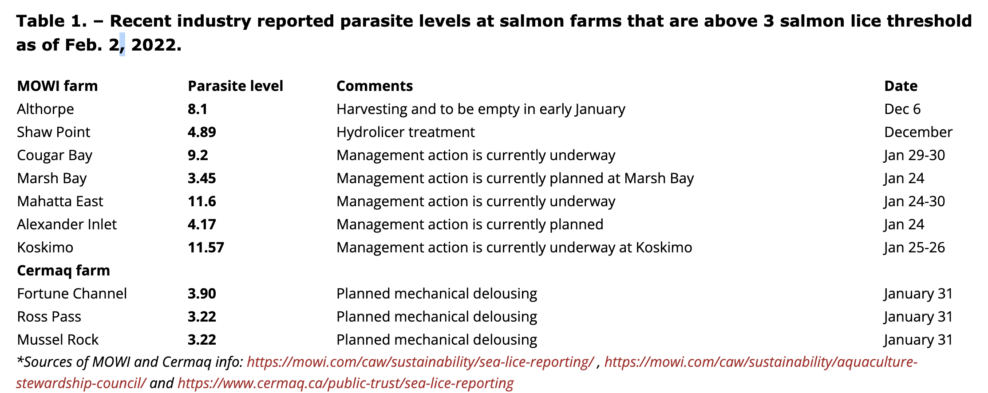Next time you’re standing at your local supermarket meat counter thinking about buying some factory-farmed Atlantic salmon, you may want to think again.
We know–it’s usually cheaper. But there is a reason for that.
Did you know that Fisheries and Oceans Canada (DFO) lets each factory farm have an average of three salmon lice parasites on each farmed fish? But that limit is only really enforced from March 1st to June 1st.
Yuck! And it gets even worse.
The March 1st deadline is coming up. And some of the factory feedlots are over this limit. That means most of their farmed fish have way more salmon lice parasites than they’re allowed.
Stan Proboszcz, a Science Advisor with Watershed Watch Salmon Society, published a chart highlighting the high parasite levels at a few of the factory fish farms in the NorthIsle. It’s alarming.

Note that some of these farms are three to four times over the legal limit. Double Yuck!
Now, these parasites aren’t in the salmon fillets you buy at the store. The parasites are cut off before the fish get packaged, but it’s still gross. And outside the spring window, there’s no real enforcement of the 3 lice limit on the salmon.
And these parasites can be devastating to wild fish. Young wild fish don’t have many sea lice because they have so much ocean to live in. But they can get infected when they swim near floating fish farms with lice outbreaks. Only the sea lice are so big compared to juvenile salmon, it would be like having a chicken chewing on your leg.
That’s why the factory farm companies are trying desperately to scrub the lice off before DFO’s deadline of March 1st.
That’s the day DFO has determined that juvenile wild salmon will start migrating from freshwater streams into saltwater. All those little wild salmon will leave the rivers and have to swim past the factory farms to reach the open ocean.
So that’s the deadline DFO has set for the companies like Mowi and Cermaq to scrub their farmed salmon, so they’re below the three-parasite limit.
But the scrubbing process is also pretty gross.
For a long time, the go-to pesticide used to kill the parasites was known as SLICE. Then, a few years ago, SLICE stopped working—the sea lice parasites in BC became immune to the drug.
Now the companies have had to buy wildly expensive boats to get rid of the parasites on their farmed fish. Some bathe the fish for hours in freshwater, which kills the sea lice. Others use chemicals like peroxide, and others mechanically scrub each fish. But each method leaves a gross sludge of sea lice and chemicals.
What do the companies do with the sludge?
They dump it in the ocean.
You may have seen our earlier story with those funny maps that show the paths of the various boats cleaning and dumping sea lice.
So the next time you’re thinking of buying that cheap package of farmed salmon, imagine all the parasites it may have been covered in and buy something else.
Editor’s note: this article was updated on February 14 to clarify that limits on sea lice per salmon are only really enforced from March 1st to June 1st.









